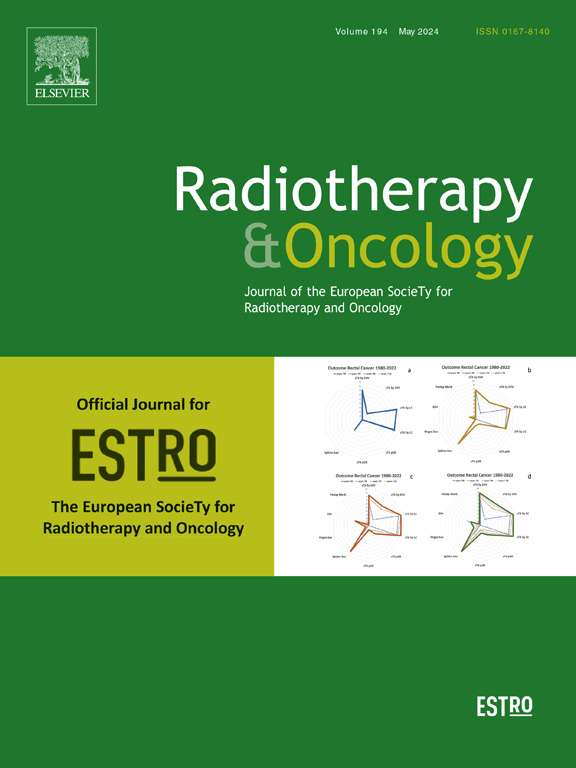Intrafraction motion stability of open vs. closed facemasks in head and neck radiotherapy: Insights from the OPEN phase III trial
IF 4.9
1区 医学
Q1 ONCOLOGY
引用次数: 0
Abstract
Purpose
This OPEN (Optimising Patient Experience in Head and Neck Radiotherapy) phase III trial sub-study, aimed to evaluate intrafraction motion in head and neck (H&N) cancer patients using three different facemask designs. Specifically, we compared intrafraction motion among patients immobilized with a closed facemask or one of two open-face designs, utilizing pre-/post-cone-beam computed tomography (CBCT) and surface-guided radiation therapy (SGRT).
Methods
A pre-planned interim analysis on the first 56 patients enrolled in the OPEN trial was conducted as a safety checkpoint. In the OPEN trial, patients are randomised into three arms: closed facemask, 3-point open facemask, or 5-point open facemask. Intrafraction motion was assessed using both CBCT and SGRT. CBCT provided deviations in translational and rotational dimensions based on bony alignment, while SGRT offered continuous monitoring of surface motion. Intrafraction motion metrics, (i.e. mean, standard deviation, maximum absolute deviation, and the 95th percentile of surface motion) were recorded for each open mask patient using SGRT data to fully quantify motion variation during treatment. The 95th percentile of SGRT deviations was used for direct comparison with CBCT motion data. Bayesian analysis was conducted to determine the equivalence of motion across mask types and measurement techniques. Margins to account for intrafraction motion were calculated across mask types using Van Herk’s formulism.
Results
Mean CBCT deviations were less than 0.4 mm and 0.2 degrees, while SGRT recorded 95th percentile deviations of 0.4 mm and 0.8 degrees over all patients. SGRT detected transient maximum deviations not captured by CBCT, particularly in the yaw axis. However, these differences were transient. Bayesian analysis showed no clinically significant differences in intrafraction motion between mask types or measurement methods. No correlation was found between SGRT and CBCT measured motion within the small range of motion recorded. No difference in intrafraction margin requirements were found between arms. Based on CBCT-measured intrafraction motion, margins of 1.8 mm, 1.7 mm, and 1.3 mm were calculated for the vertical (VRT), lateral (LAT), and longitudinal (LNG) directions, respectively, to account for intrafraction motion for all mask types, with SGRT confirming that patient motion during treatment remained within these margins.
Conclusions
Intrafraction motion, as measured by both CBCT and SGRT, remains within clinically acceptable limits and yields similar PTV margins across both open and closed mask types. Intrafraction PTV margins were found to be comparable across all mask types. The use of SGRT allowed for the detection of transient deviations and rotational differences that were not detected using CBCT alone. Overall, these findings confirm that both 3-point and 5-point open-face masks achieve intrafraction stability comparable to traditional closed facemasks in head and neck radiotherapy.
开放与封闭面罩在头颈部放疗中的屈光内运动稳定性:来自open III期试验的见解
目的:本OPEN(优化头颈部放疗患者体验)III期试验亚研究旨在评估使用三种不同面罩设计的头颈部(H&;N)癌症患者的屈光运动。具体来说,我们利用锥形束前/后计算机断层扫描(CBCT)和表面引导放射治疗(SGRT),比较了使用封闭式口罩或两种开放式设计之一固定的患者的屈光内运动。方法对首批56例OPEN试验患者进行预先计划的中期分析,作为安全检查点。在OPEN试验中,患者被随机分为三组:封闭式口罩、3点开放式口罩和5点开放式口罩。使用CBCT和SGRT评估屈光内运动。CBCT提供了基于骨对齐的平移和旋转尺寸偏差,而SGRT提供了对表面运动的连续监测。使用SGRT数据记录每位开放面罩患者的屈光度运动指标(即平均值、标准差、最大绝对偏差和表面运动的第95百分位),以充分量化治疗期间的运动变化。SGRT偏差的第95个百分位与CBCT运动数据进行直接比较。进行贝叶斯分析以确定跨掩模类型和测量技术的运动等效性。利用Van Herk的公式计算了不同遮罩类型的边缘,以解释内部的运动。结果所有患者的CBCT平均偏差小于0.4 mm和0.2度,而SGRT记录的95百分位偏差为0.4 mm和0.8度。SGRT检测到CBCT未捕获的瞬时最大偏差,特别是在偏航轴上。然而,这些差异是短暂的。贝叶斯分析显示,不同的眼罩类型和测量方法在屈光内运动方面无显著差异。在运动记录的小范围内,SGRT和CBCT测量的运动没有相关性。在两臂之间没有发现吸积裕度要求的差异。基于cbct测量的屈光内运动,分别计算了垂直(VRT)、横向(LAT)和纵向(LNG)方向的1.8 mm、1.7 mm和1.3 mm的边缘,以解释所有掩膜类型的屈光内运动,SGRT确认患者在治疗期间的运动保持在这些边缘内。结论CBCT和SGRT测量的牵引运动保持在临床可接受的范围内,并且在开放式和封闭式面罩类型中产生相似的PTV边缘。发现所有掩膜类型的屈光内PTV边缘具有可比性。SGRT的使用允许检测瞬态偏差和旋转差异,这是单独使用CBCT无法检测到的。总的来说,这些研究结果证实,在头颈部放疗中,3点和5点开放式面罩与传统的封闭式面罩相比,都能达到屈光内稳定性。
本文章由计算机程序翻译,如有差异,请以英文原文为准。
求助全文
约1分钟内获得全文
求助全文
来源期刊

Radiotherapy and Oncology
医学-核医学
CiteScore
10.30
自引率
10.50%
发文量
2445
审稿时长
45 days
期刊介绍:
Radiotherapy and Oncology publishes papers describing original research as well as review articles. It covers areas of interest relating to radiation oncology. This includes: clinical radiotherapy, combined modality treatment, translational studies, epidemiological outcomes, imaging, dosimetry, and radiation therapy planning, experimental work in radiobiology, chemobiology, hyperthermia and tumour biology, as well as data science in radiation oncology and physics aspects relevant to oncology.Papers on more general aspects of interest to the radiation oncologist including chemotherapy, surgery and immunology are also published.
 求助内容:
求助内容: 应助结果提醒方式:
应助结果提醒方式:


